提起荷兰你会想起什么?是天才画家梵高笔下那一团团如火焰般炽烈的向日葵?还是那迎风摇曳、令人迷醉的郁金香?抑或是转动在蓝天白云之下、诉说着古老故事的风车?荷兰虽是一个童话般的小小国度,但却拥有众多享誉世界的文化名片。正是这些不可复制的名片为荷兰赢得了无数的美誉:“欧洲的后花园”“童话王国”“风车之国”……且随本文一起来领略这一梦幻王国的独特文化魅力。
Holland may be a small country, but it still manages to have some of the world’s best-known national symbols. Tell someone the name “Holland”, and even if they know nothing of the country they’ll still likely be able to rattle off1) a list of clichés2). Here are some of the more notable Dutch clichés and the stories behind them.
荷兰也许只是个小国家,但它依然拥有世界上最为著名的一些国家象征。只要对某人说起“荷兰”这个名字,哪怕他对这个国家一无所知,仍然可能会一口气说出一大串家喻户晓的名词来。本文讲述的就是荷兰最为著名的一些象征性符号及其背后的故事。
Tulips 郁金香——“偷”来的国花
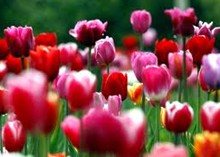 Tulips are Holland’s national flower, and when in season you can view vast fields of them in certain parts of the country.
Tulips are Holland’s national flower, and when in season you can view vast fields of them in certain parts of the country.
Oddly enough, tulips have actually gotten somewhat controversial as of late3). You see, the flowers are not native to Holland, and the only reason they even have them in the first place is because Dutch marauders4) stole them from Turkey in the 17th century. The Turks resent this, and in recent years have tried to reclaim the tulip as their own national symbol. For example, the official Turkey tourism logo now features a prominent tulip, and even in Canada, the once exclusively Dutch Ottawa Tulip Festival5) is now “jointly hosted” by Holland and Turkey in a gesture of fairness.
郁金香是荷兰的国花,每到花季,在荷兰的某些地方,你总可以看到大片大片盛开的郁金香。
但说来也怪,其实郁金香最近也引发了一些争议。要知道,荷兰并非郁金香的原产地,郁金香最初之所以能够传到荷兰,是因为17世纪荷兰的掠夺者将它们从土耳其偷窃了过来。土耳其人对此耿耿于怀,最近几年一直试图将郁金香夺回来,将其变成自己国家的象征。信号之一就是土耳其官方的旅游徽标现在变成了一朵盛开的郁金香。更有甚者,在加拿大,一向由荷兰独立举办的渥太华郁金香节现在也成了由荷兰和土耳其“联合举办”,以示公平。
Wooden Shoes 木鞋——劳动人民的最爱
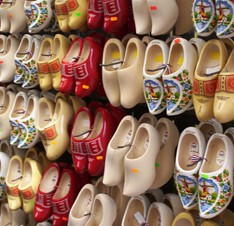 Wooden shoes, also known as “clogs6)” or “klompen7)” in Dutch, are a holdover8) from Holland’s agricultural roots. In the days before plastic and rubber became mainstream, wood was a cheap, readily available material for making strong, waterproof shoes that were perfect for working long days in the fields. As Holland remained a nation of farmers until very recently, clogs were the most common form of working-class footwear well into the early 20th century.
Wooden shoes, also known as “clogs6)” or “klompen7)” in Dutch, are a holdover8) from Holland’s agricultural roots. In the days before plastic and rubber became mainstream, wood was a cheap, readily available material for making strong, waterproof shoes that were perfect for working long days in the fields. As Holland remained a nation of farmers until very recently, clogs were the most common form of working-class footwear well into the early 20th century.
Some people still wear wooden shoes today—usually just farmers and other people who spend a lot of time wading through dirt. The clogs that you can buy in most stores are intended more for decorative purposes. Real clogs intended for wearing are usually far less attractive.
木鞋,荷兰人又称作“木屐”或“木底鞋”,是荷兰农业时代遗留下来的产物。在塑料和橡胶尚未成为主流的时期,木头是一种廉价又随处可得的材料,可用来制造坚固、防水的鞋子,适于长时间在田间劳作时穿。由于荷兰不久以前还是一个农业国家,因而直到进入20世纪初期,木鞋还一直是劳动阶级中最为常见的鞋具。
现在有些荷兰人仍然喜欢穿木鞋——通常是农民和其他一些需要长期在泥土里劳作的人们。在大多数商店里所买到的那些木鞋都是用来作装饰的,一般来说,真正用来穿的木鞋可远远没有那么漂亮。
Windmills 风车——蓝天白云下的亮丽风景
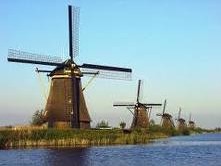 Another former staple9) of Dutch agricultural life, mills were originally used for all sorts of practical purposes such as grinding flour, sawing wood, or pumping water. Today they’ve mostly been rendered obsolete by modern machinery, but some can still be seen operating in the Dutch countryside. Because they’re such treasured national symbols, there is a windmill conservation movement in Holland that seeks to preserve the remaining survivors.
Another former staple9) of Dutch agricultural life, mills were originally used for all sorts of practical purposes such as grinding flour, sawing wood, or pumping water. Today they’ve mostly been rendered obsolete by modern machinery, but some can still be seen operating in the Dutch countryside. Because they’re such treasured national symbols, there is a windmill conservation movement in Holland that seeks to preserve the remaining survivors.
Though windmills may be disappearing, wind turbines10) are plentiful. Because Holland is so flat and windy, wind power remains a popular source of energy. When you’re driving across long stretches of flat farmland, collections of tall, white wind turbines are a common sight.
荷兰农业社会遗留下来的另一特色物品是风车。风车最早是用于各种实用目的,如磨制面粉、锯木材或者抽水。如今,大多数风车因现代化机械的使用都已被淘汰,但在荷兰乡村仍然可以看到一些风车在运转。由于风车已成为宝贵的民族象征,荷兰就发起了风车保护运动,旨在保护这些现存的风车。
尽管风车可能会逐渐消失,但风力涡轮机还大量存在。由于荷兰地势平坦,风力充足,风能依然是一种常见的能源。当你驱车穿过狭长、平坦的乡间农田时,高大的白色风轮机组是一道随处可见的亮丽风景。
Cheese奶酪——一如既往的挚爱
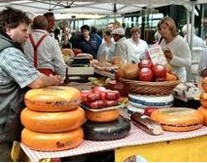 The Dutch are known for being fond of their cheese. After all, every postcard from the Netherlands that doesn’t feature tulips seems to be of a piece of cheese. In fact, the Dutch are such famous cheese-eaters that they are known abroad as “cheese-heads”.
The Dutch are known for being fond of their cheese. After all, every postcard from the Netherlands that doesn’t feature tulips seems to be of a piece of cheese. In fact, the Dutch are such famous cheese-eaters that they are known abroad as “cheese-heads”.
It’s hard not to see how important cheese is to the Dutch way of life. You only need to take a look at the phenomenally high consumption of cheese in the country—on average, about 15 kg of cheese per person each year—to see how highly it is prized. Some scientists say all this cheese eating accounts for the high average height of the Dutch; almost everyone says it accounts for the wide average girth of the Dutch.
Then there is the hugely profitable cheese export, which may be the reason for all the ‘cheese-head’ mutterings11) abroad. The Netherlands produces over 630,000 tons of cheese, and almost 500,000 tons of it are shipped out to the United States and the rest of the world, to earn the title of World’s Biggest Cheese Exporter.
荷兰人素以喜爱奶酪而著称。这么说吧,来自荷兰的明信片上如果没有郁金香,就很可能会有奶酪。事实上,荷兰人喜爱吃奶酪几乎世人皆知,以至于在国外人们都称荷兰人为“奶酪脑袋”。
不难看出,奶酪对于荷兰人的生活方式是多么重要。只要看一看荷兰人对奶酪不同寻常的巨大消费就可知晓他们对奶酪的喜爱程度:平均来说,每人每年大约要吃掉十五公斤奶酪。有些科学家认为,荷兰人奶酪吃得多,所以有高于常人的平均身高;而几乎所有人都认为,荷兰人奶酪吃得多,所以有大于常人的平均腰围。
于是荷兰人就有了利润极高的奶酪出口贸易,这也许就是为什么其他国家的人们都不满地称他们为“奶酪脑袋”。荷兰每年的奶酪产量高达六十三万多吨,其中有近五十万吨出口到美国和世界其他国家,因此被称作“世界上最大的奶酪出口国”。
National Anthem国歌——威廉王子的“迷你”自传
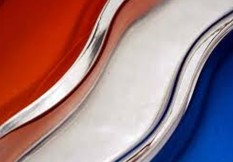 The Dutch national anthem is supposedly the world’s oldest, but it’s also one of the strangest. It’s basically just a short autobiographical summary of Prince William12) of Orange, as sung by himself. So when you sing the Dutch anthem you are essentially speaking as the prince, which sounds a bit odd. Here are the lyrics:
The Dutch national anthem is supposedly the world’s oldest, but it’s also one of the strangest. It’s basically just a short autobiographical summary of Prince William12) of Orange, as sung by himself. So when you sing the Dutch anthem you are essentially speaking as the prince, which sounds a bit odd. Here are the lyrics:
William of Nassau13) A Prince of Orange
Am I, of German descent Am I, free and fearless
Loyal to the fatherland The king of Spain
I will remain until I die I have always honored
荷兰的国歌据说是世界上最古老的国歌,但同时也是最古怪的国歌之一。它基本上就是奥兰治王朝(编者注:也译作“橙色王朝”)中威廉王子的一个简短自传,由王子本人演唱。因此,当你在唱荷兰国歌时,也就相当于在以王子的口吻讲话,听起来实在有点古怪。下面就是这首国歌的歌词:
拿骚的威廉 奥兰治王朝的王子
就是我,日耳曼的后裔 就是我,自由、无畏
忠于祖国 西班牙王
至死不渝 是我永远的荣耀
Bicycle自行车——单车上的逍遥生活
In the everyday life of Holland the bike is a familiar sight. Sixteen million people own approximately thirteen million bicycles! Nearly everyone has one, and some people even have two: a Dutchman without a bike is like a fish without water! Holland is the ultimate cycling country. The Dutch use the bicycle as a means of transportation rather than just a recreational sport: using their bike for daily shopping and to commute to work.
Obligatory separate bicycle lanes are indicated by the round blue sign with a white bicycle in the middle. In many parts, you will find superbly indicated special routes for cyclists which will lead you through some of the most attractive regions of Holland. Holland’s excellent bicycle path network is clearly marked with the ANWB’s (Royal Dutch Touring Club) red and white signs and mushrooms-shaped posts, indicating the quickest route from A to B. Many companies specialize in the rent and repair of bicycles. Special events for cyclists are regularly organized. In short, Holland is a “cyclist friendly” country with a climate characterized by mild winters and comfortable summers.
在荷兰人的日常生活中,自行车随处可见。一千六百万的人口拥有大约一千三百万辆自行车!几乎人手一辆,有的人甚至拥有两辆:荷兰人离开了自行车,就像是鱼儿没有了水。荷兰是自行车的终极王国。荷兰人把自行车当做交通工具,而不是娱乐性的运动:他们骑自行车进行日常购物、上下班。
与其他道路分离开来的固定自行车道的标志是一个圆形的蓝色标志,中间是一辆白色的自行车。在荷兰的许多地方,你都会发现专为骑自行车者设计的标识清晰的特殊路线,它们会引导你穿过荷兰最引人入胜的一些地区。荷兰卓越的自行车交通网络都清晰地标有荷兰皇家旅行俱乐部的红白标记以及蘑菇形状的柱子图形,标明A、B两地间的最快路线。许多公司专门从事自行车租赁和维修业务,此外还会定期举办专为骑自行车者设计的特别活动。总之,荷兰的气候冬天温和,夏季舒适,是“骑车者的乐园”。
Marijuana 大麻——毒品也合法
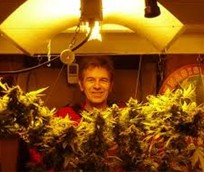 There is a widespread belief in much of the world that pot14) is 100% legal in all of Holland. In reality the situation is much more complex. Generally speaking, pot is only to be smoked indoors, either in your private home or in a licensed bar. Smoking pot anywhere else, especially in a public place, is as frowned upon—and illegal—in Holland as it is anywhere else. Possessing five ounces of marijuana is not illegal, but any more than that and you could get busted for drug possession.
There is a widespread belief in much of the world that pot14) is 100% legal in all of Holland. In reality the situation is much more complex. Generally speaking, pot is only to be smoked indoors, either in your private home or in a licensed bar. Smoking pot anywhere else, especially in a public place, is as frowned upon—and illegal—in Holland as it is anywhere else. Possessing five ounces of marijuana is not illegal, but any more than that and you could get busted for drug possession.
All this being said, “pot” and “Holland” are increasingly becoming synonymous, and these days the drug is frequently used as a tourist attraction of sorts. In many tourist towns—Amsterdam especially—you can buy all sorts of crap with marijuana leaves on it, like T-shirts, ashtrays, keychains, and backpacks. The famed “Coffee Shops” in which pot is legally allowed to be smoked are also becoming big attractions for the international stoner15) crowd.
在世界上许多地方都有一种普遍的观点,认为大麻在整个荷兰都是百分百合法的。但实际上情况要复杂得多。一般来说,大麻只能在室内吸食,要么在你自己家里,要么在政府特许的酒吧里。在其他任何地方吸食大麻都是不受欢迎且不合法的,尤其是在公共场合——在这一点上,荷兰和世界其他任何地方都是一样的。拥有五盎司的大麻并不算违法,但超过这个量你就可能会因为私藏毒品而身败名裂。
虽然如此,“大麻”和“荷兰”正愈来愈成为一对同义词,而且大麻近来也经常被用作某种吸引游客的东西。在许多旅游城市——尤其是在阿姆斯特丹——你可以买到各种印有大麻叶子的廉价物品,如T恤、烟灰缸、钥匙链和背包等等。一些著名的“咖啡店”是吸食大麻的合法场所,那里正以巨大的吸引力吸引着来自世界各地的大麻吸食者。
1. rattle off:(不费力地)飞快说出(或写出);rattle [5rAtl] vi. 发连续短促的尖叫声
2. cliché [5kli:FeI] n. 陈词滥调,用滥了的套语
3. as of late:最近,近来
4. marauder [mE5rC:dE(r)] n. 掠夺者
5. Ottawa Tulip Festival:渥太华郁金香节,世界上最大的郁金香节,于每年的5月举行。
6. clog [klC^] n. 木屐
7. klompen [5klRmpEn] n.荷兰人穿的木底鞋
8. holdover [5hEJld7EJvE(r)] n.〈美〉自前一时代过来的人(或物);剩余物
9. staple [5steIpl] n. 主要产品(或商品)
10. turbine [5tE:bIn, -baIn] n. 涡轮机
11. mutter [5mQtE] vi.小声抱怨
12. Prince William:威廉王子(1533~1584),即荷兰奥兰治王朝的开国国王(1559~1584年在位),被荷兰人称为“祖国之父”。
13. Nassau [5nAsC:] n. 拿骚,巴哈马首都
14. pot [pCt] n.〈口〉大麻
15. stoner [5stEunE(r)] n.〈口〉(尤指吸食大麻的)瘾君子
